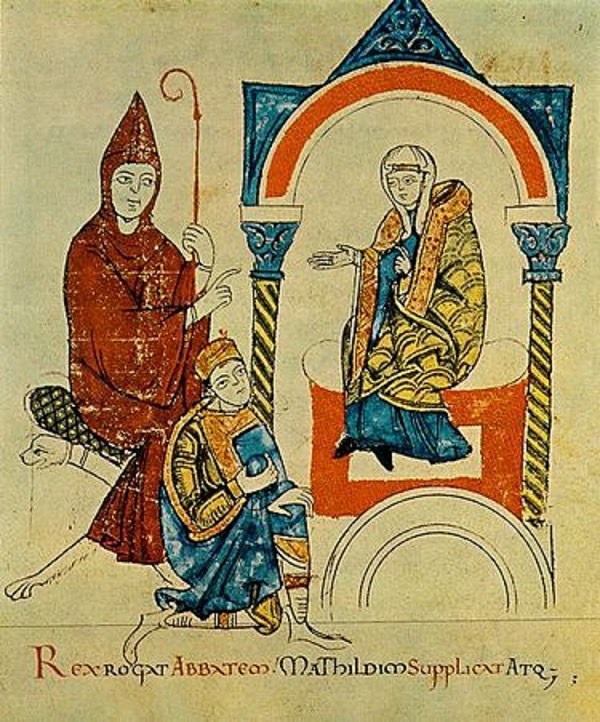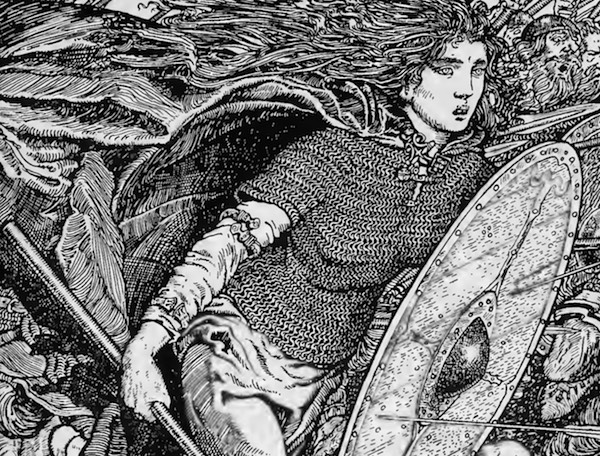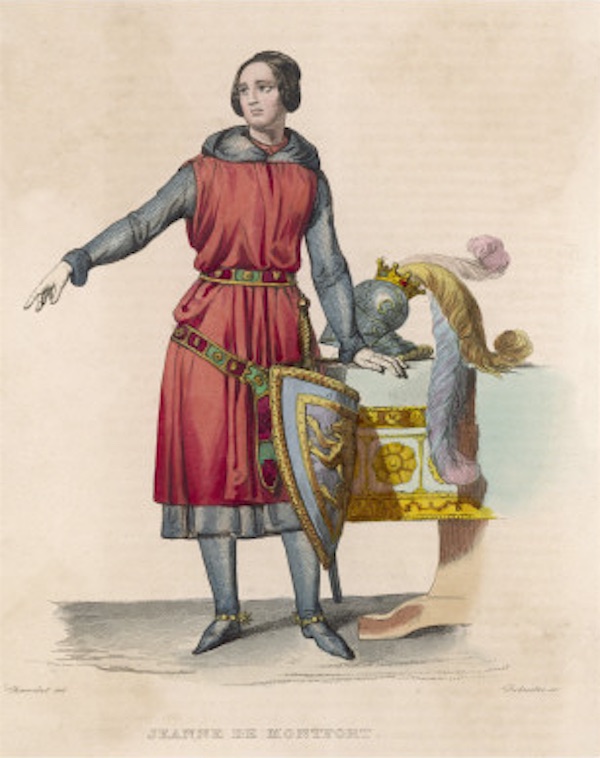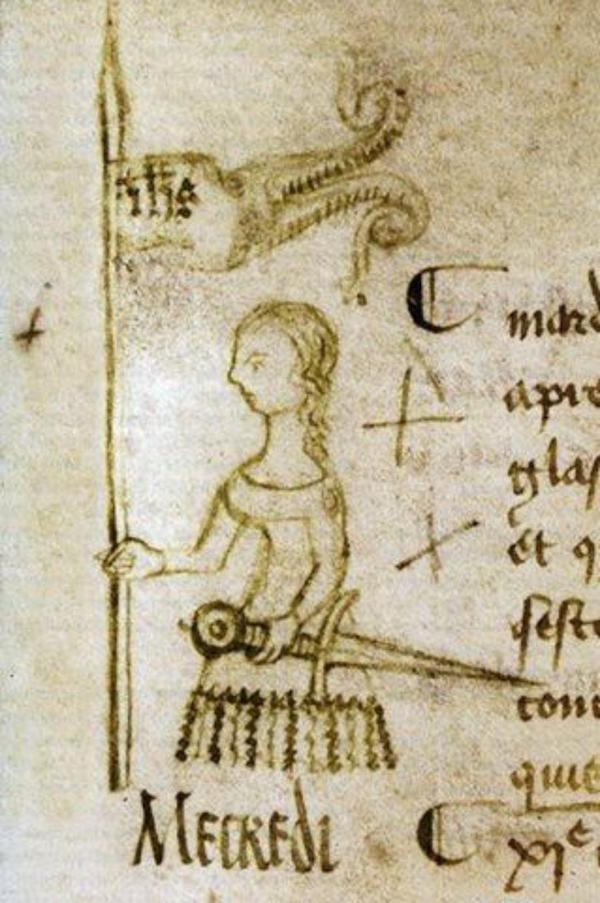So I watched Batman v Superman. You don’t need a medievalist wandering through your digital space just to pile on with the many things that went wrong with the film, so instead let me say this:
In a dark world of brooding boys, Wonder Woman’s every moment on screen was like the light of a sun threatening to break through the clouds. There were many reasons for this (number one: Gal Gadot is a terrific actress), but what struck me as I was watching the film was the fact that Wonder Woman seemed to be the only person on screen with a clear sense of purpose. No brooding and self-doubt and angst and what-not for her: Wonder Woman knows exactly who she is.
And who she is, obviously, is a woman who kicks ass.
Go back and watch the final battle again. Near the end, when seemingly all hope is lost, after she’s just been pounded through the fourteenth car on a ruinous landscape, she slides to a stop in the debris and the camera closes in on her. And in that moment of peril and pain, she smiles.
Because this is what she is. She’s a warrior. She was born to do this. She lives to do this.

Which reminded me, because I am a medievalist, of the long line of amazing women in history who don’t always get the notice they deserve. During the publicity for the release of Shards of Heaven, I wrote a short blog post about “Five Amazing Women in Ancient Rome,” so today I thought I’d follow that up with “Five Amazing Women in the Middle Ages.”
Awesome, right? Except, well, the list of amazing medieval women that popped into my mind is massive. Amalasuntha, Christine de Pizan, Isabella of France, Hrotsvitha, Catherine of Valois, Hildegard of Bingen, Isabella of Castille … I could write post after post on these (and so many other) remarkable figures. And that’s just dealing with some of the Big Names. Because there are so many whose songs have gone largely unsung.
For instance, in 1999, Father George Dennis found a note slipped into the pages of an obscure manuscript in the Mediceo-Laurentian Library in Florence. Stuck in between the writings of the Byzantine monastic theologian Maximos Planoudis, a poem on meter, and the works of the late antique Greek rhetorician Libanius—I told you this was an obscure manuscript!—was this passage:
In the part of Karia just opposite Chios, it is reported that, in our own day, a mature woman, with some facial hair, named Makouraino, married and with children, displayed her valor and leadership when the occasion presented itself. What she did was no less than what a man would do, indeed what the bravest men would do. For her ability to stretch tight and stiff bows was awesome. It is said that, by herself, she stood up to two pirate ships and drove them from the shore by firing arrows at them. In the year 1341.
We know nothing else of her. The story is nowhere else preserved. But she sounds amazing.
All this to say, even if I’m going to confine myself to a list of just those amazing women whose stories have survived, it would be far too long. I have to cut it down somehow. And what with Wonder Woman and Makouraino both being warriors and all, I give you…
Five Amazing Women Warriors in the Middle Ages
Matilda of Tuscany

The Great Countess was a force of nature in Italy for nearly forty years. A brilliant and multi-lingual woman, Matilda was a key figure in the long and complicated Investiture Controversy. After an excommunicated Emperor Henry IV walked to her castle at Canossa and for three days knelt in the snow at its gates, it was Matilda who convinced Pope Gregory VII to meet him and restore him to the Church. In the years that followed she was one of the papacy’s staunchest allies, often taking to the field at the direct head of her forces to defend first Gregory and then his successor Pope Urban II against Henry IV and his own successors. Through decades of political dynamics and military maneuvering, it was Matilda who came out on top. In 1111, Emperor Henry V crowned her Imperial Vicar and Vice-Queen of Italy, a title she would hold until her death in 1115. In 1645, her remains were transferred to St Peter’s Basilica in Rome, one of only three women to hold such honor. The stunning facade of her tomb was designed by the famed sculptor Bernini himself.
Lagertha

One of the best books no one has heard of, the Gesta Danorum, by the 12th-century monk, Saxo Grammaticus, recounts the story of Lagertha. Born into the family of King Siward of Norway, she and other female relatives were forced into prostitution by King Frø of Sweden when he defeated Siward. The dead king’s grandson, Ragnar Lodbrok (the protagonist of The History Channel’s Vikings show) went to war against Frø to avenge Siward, and several of these abused women took arms alongside Ragnar’s forces. Lagertha is described as an Amazon among them, hewing her foes and leading them all to victory. Ragnar eventually courts her as his wife—killing a bear and a hound with a spear and his bare hands to do so. Because, you know, Vikings. He eventually divorced her in favor of a political marriage to a Swedish princess, but Lagertha still came to his aid when he was in need and saved his life when he faced civil war in Denmark. And then, when her second husband proved unworthy, she cut him down with the point of a spear that she concealed in the folds of her dress. After that, she ruled over vast lands in her own authority (and as a badass, still) until the time of her death.
(For the sake of transparency, I should admit that Lagertha might well be a fiction. There is good reason to believe that her story and her name are the result of a series of misreadings of tales about the minor Norse deity, Thorgerd. But there’s a chance she was real. And by the gods, I want her to be so!)
Jeanne Hachette

Born Jeanne Fourquet or Laisné, this peasant girl earned her name in history by wielding—you guessed it—a hatchet. On June 27, 1472, just over four decades after the death of fellow Frenchwoman Joan of Arc, Jeanne was a citizen of the town of Beauvais, which was besieged by the forces of the Duke of Burgundy. That day, the Burgundians made a furious assault, and according to the stories they managed to make their way onto the battlements of the town. In declaration of the impending victory, a Burgundian planted a flag upon the battlement—a deeply symbolic act of victory, as the Americans who raised the flag on Iwo Jima can attest. In that perilous moment, with the future of her city in doubt, Jeanne took in hand an axe and rushed the flag. She smote the man, tore down the flag, and the tide of the siege was turned.
Joanna of Flanders

When the Duke of Brittany died without heir in 1341, there were two rival claimants for the duchy: Charles of Blois and John of Montfort. John traveled to the court of King Philip VI of France to press his claim, but Philip —who just happened to be Charles’ nephew—instead imprisoned him. Rather than capitulate to this act, John’s wife, Joanna of Flanders, declared their infant son the de facto leader of the Montfort claim and promptly declared war against the House of Blois. What would become known as the War of the Breton Succession became a kind of “Cold War” during a time of supposed truce in the Hundred Years War when Joanna called upon King Edward III of England to defend her claim. In one of her many moments of triumph, she was besieged in the two of Hennebont by the forces of Charles. Touring her fortifications, she saw that the enemy encampment was ill-defended and so, donning armor and taking arms, she led a raid that burned the enemy’s tents and supply lines and then went on to seize another nearby town. For the daring action she is known as “Jeanne la Flamme,” and it was just one of her many exploits. The chronicler Jean le Bel declared that she “was indeed a courageous woman,” and the famed writer Jean Froissart agreed: “she had the heart of a lion.”
Joan of Arc

Of course. I mean, obviously. The Maid of Orléans is one of the most remarkable figures in history: of any kind, of any gender, of any age. At the age of sixteen, with the kingdom of France teetering in the Hundred Years War with England, she walked from her home in Domrémy to the town of Vaucouleurs. She asked to see the garrison commander, and she informed him that God had told her that she needed to stand at the king’s side in the war. According to legend, she told him that divine revelation had also informed her that French forces had been defeated at the Battle of Rouvray. When word later arrived that this was, in fact, true, she was granted an escort to Chinon, where she met the king. Within months she led the French forces that lifted the siege of Orléans—the first in a striking series of victories. Captured in an ambush on 23 May 1430 (she could have escaped but stayed with the rear guard in order to allow others to do so), she was transferred into English hands and put on trial for ecclesiastical crimes. She was burned at the stake on 30 May 1431. Whether you or I believe that she truly heard voices of divine inspiration is immaterial: she believed that she did, and so did the many men who fought and died behind her banner.
There you go. Five amazing women warriors of the Middle Ages. Already I want to add more!
If you want to read more about some amazing medieval women (including many I didn’t discuss here), take a look at “Sex, Society, and Medieval Women,” a wonderful web resource by N.M. Heckel, hosted by the Robbins Library at the University of Rochester.
 Michael Livingston is a Professor of Medieval Literature at The Citadel who has written extensively both on medieval history and on modern medievalism. His historical fantasy series set in Ancient Rome, The Shards of Heaven and its sequel The Gates of Hell, is available from Tor Books.
Michael Livingston is a Professor of Medieval Literature at The Citadel who has written extensively both on medieval history and on modern medievalism. His historical fantasy series set in Ancient Rome, The Shards of Heaven and its sequel The Gates of Hell, is available from Tor Books.










